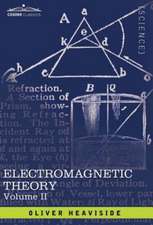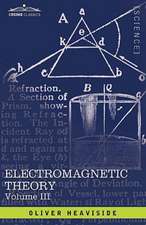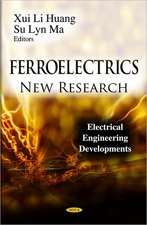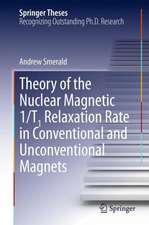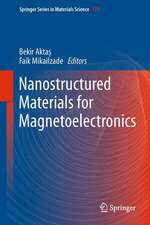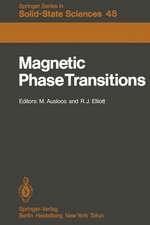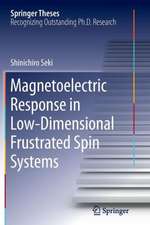Dynamic Spin-Fluctuation Theory of Metallic Magnetism
Autor Nikolai B. Melnikov, Boris I. Reseren Limba Engleză Hardback – 17 aug 2018
The book is intended primarily for researchers, but can also be used as textbook. The introductory chapters offer clear and complete derivations of the fundamentals, which makes the presentation self-contained. The main text is followed by a number of well-organized appendices that contain a detailed presentation of the necessary many-body techniques and computational methods. The book also includes a list of symbols and detailed index. This volume will be of interest to a wide range of physicists interested in magnetism and solid state physics in general, both theoreticians and experimentalists.
Preț: 598.64 lei
Preț vechi: 748.29 lei
-20% Nou
Puncte Express: 898
Preț estimativ în valută:
114.57€ • 119.17$ • 94.58£
114.57€ • 119.17$ • 94.58£
Carte tipărită la comandă
Livrare economică 10-16 aprilie
Preluare comenzi: 021 569.72.76
Specificații
ISBN-13: 9783319929729
ISBN-10: 3319929720
Pagini: 312
Ilustrații: XVIII, 287 p. 59 illus., 18 illus. in color.
Dimensiuni: 210 x 279 mm
Ediția:1st ed. 2018
Editura: Springer International Publishing
Colecția Springer
Locul publicării:Cham, Switzerland
ISBN-10: 3319929720
Pagini: 312
Ilustrații: XVIII, 287 p. 59 illus., 18 illus. in color.
Dimensiuni: 210 x 279 mm
Ediția:1st ed. 2018
Editura: Springer International Publishing
Colecția Springer
Locul publicării:Cham, Switzerland
Cuprins
Introduction.- Basics of Metallic Magnetism.- Many-Electron Problem.- Mean-Field Theory.- Random-Phase Approximation.- Green Functions at Finite Temperatures.- Spin-Fluctuation Theory in the Ising Model.- Functional Integral Method.- Gaussian Approximation.- Single-Site Gaussian Approximation.- High-Temperature Theory.- Low-Temperature Theory.- Temperature Dependence of Magnetic Characteristics.- Neutron Scattering in Metals.- Short-Range Order Above TC.- Conclusion.- Appendices.- Index.
Textul de pe ultima copertă
This book presents a theoretical framework for magnetism in ferromagnetic metals and alloys at finite temperatures. The objective of the book is twofold. First, it gives a detailed presentation of the dynamic spin-fluctuation theory that takes into account both local and long-wave spin fluctuations with any frequency. The authors provide a detailed explanation of the fundamental role of quantum spin fluctuations in the mechanism of metallic magnetism and illustrate the theory with concrete examples. The second objective of the book is to give an accurate and self-contained presentation of many-body techniques such as the functional integral method and Green's functions, via a number of worked examples. These computational methods are of great use to solid state physicists working in a range of specialties.
The book is intended primarily for researchers, but can also be used as textbook. The introductory chapters offer clear and complete derivations of the fundamentals, which makes the presentation self-contained. The main text is followed by a number of well-organized appendices that contain a detailed presentation of the necessary many-body techniques and computational methods. The book also includes a list of symbols and detailed index. This volume will be of interest to a wide range of physicists interested in magnetism and solid state physics in general, both theoreticians and experimentalists.
The book is intended primarily for researchers, but can also be used as textbook. The introductory chapters offer clear and complete derivations of the fundamentals, which makes the presentation self-contained. The main text is followed by a number of well-organized appendices that contain a detailed presentation of the necessary many-body techniques and computational methods. The book also includes a list of symbols and detailed index. This volume will be of interest to a wide range of physicists interested in magnetism and solid state physics in general, both theoreticians and experimentalists.
Caracteristici
Provides a clear and self-contained treatment of the many-electron problem of metallic magnetism Introduces theoretical frameworks along with the necessary mathematical background Emphasizes practical problems, illustrated by concrete metals and alloys Includes detailed description of computational methods for practical applications Written at postgraduate level, with some chapters accessible to graduate students with elementary knowledge of quantum mechanics, statistical mechanics, and solid state physics




